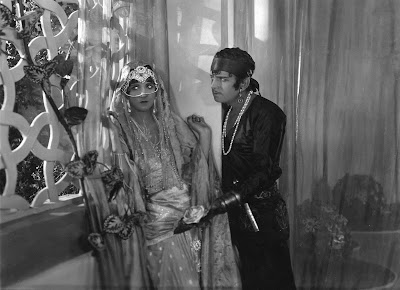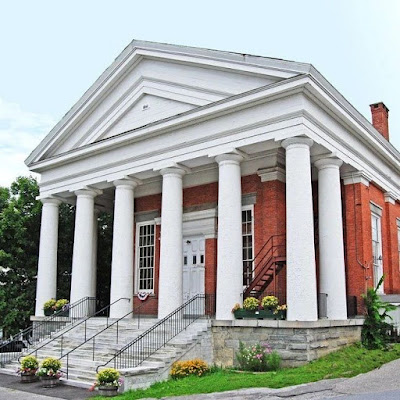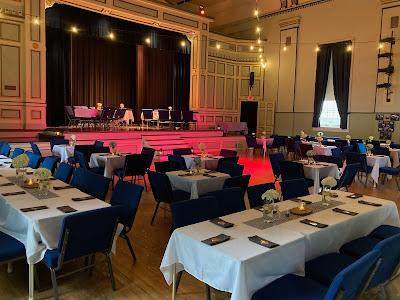Me and silent film accompanist Rodney Sauer at the Essanay Silent Film Museum in Niles, Calif.Saturday, Nov. 2 brought a double-helping of my favorite dish: silent film delight.
I got to accompany 'Daughter of the Dawn' (1920), an unusual Native American drama, at the Niles Essanay Silent Film Museum in Niles, Calif.
And I also got to see and visit with all the folks who maintain the Niles museum, the only venue I know of that runs a silent film program with live music every week all year round.
Really! Sometimes the programs can be quite creative. Later this month, Jon Mirsalis (a Bay area resident and Niles regular) will accompany the classic drama 'The Wind' (1928) in what's being described as 'Blow-A-Rama.'
All I know is that it involves the use of fans in the Niles venue, which is an original 1913 Edison theater. Wish I could be on hand. Still, it's a good enough idea that I'm considering stealing it.
Niles is a natural gathering place for the silent film community, which is why I've been journeying out there off and on (thank you, frequent flier miles!) for the past 10 years or so.
This time, I was joined by another guest accompanist: Rodney Sauer of the Mont Alto Motion Picture Orchestra, who was on hand to help out with a program honoring Native American Heritage Month, which happens to be November.
It was Rodney and his Mont Alto group (a five-member combo that specializes in scoring silent films) that first got me pointed toward exploring the craft on my own—almost 25 years ago now!
It was March 2000. On a whim, I attended the Kansas Silent Film Festival (this time, thank you Delta flight passes!) in Topeka, Kansas, where I'd never been before. There, I heard the Mont Alto group accompany the silent 'Peter Pan' (1924) and Buster Keaton's 'The Cameraman' (1928).
And I met people, including Rodney, who were so encouraging and welcoming that it eventually led to my trying my hand (or rather, both hands) at it. And here we are.
I've since had occasion to appear on the same program as Rodney, mostly at subsequent Kansas festivals, and it's always great to see him and the other Mont Alto members, catch up, and trade stories.
Rodney helped me find sheet music for when I recorded a score for Gloria Swanson's 'Zaza' (1923), and he's always been friendly and encouraging and bemused and generous.
Rodney was visiting Niles to speak about and accompany 'Ramona' (1929), starring Delores Del Rio and directed by Edwin Carewe, one of the few motion picture directors of Native American heritage, then or now.
He also introduced 'Daughter of the Dawn' (1920), the film I accompanied, providing the Saturday afternoon audience a good summary of how the film came to be, and how it was rediscovered only recently as part of a business legal settlement in Oklahoma.
Although the film has been reissued with a recorded score using appropriate and authentic Native American music, Niles is committed to showing silent films with live accompaniment. Since I qualify as live, I got the assignment.
But the thing is, I don't qualify as Native American. With me, you can take your pick: I'm one quarter Irish, Polish, Lithuanian, and/or French-Canadian. Call my ethnicity "assorted."
So my musical heritage, such as it is, is a melange of Polish polkas played on accordian (which Rodney could do, if needed), Irish step-dancing, and what I'll call Quebec-style country & western. Plus all the marching band music I absorbed in high school.
But it was Rodney who gave me a clue about how to approach 'Daughter of the Dawn'—not at Niles, but years ago at a Kansas Silent Film Festival, when he accompanied the wilderness docu-drama 'Chang' (1928) on solo piano.
I don't think Rodney's heritage includes any of the indigenous tribal peoples of southeast Asia, where the film was shot.
But I remember Rodney saying that to create an effective atmosphere, he tried to avoid "Western-style" chord progressions and modal scales—scales that to our ears might sound somewhat medieval, as in a Gregorian chant.
It seemed to work for Rodney back then. So that's what I did for 'Daughter of the Dawn.'
I took a handful of melodic scraps heavy with intervals of fourths, some flourishes built on modal scales, and wove it together as best I could to support what unfolded on the screen.
I think I struck paydirt right away with a simple device during the opening titles: a single note repeated twice, alternating off the beat in octaves, pulsing steadily along, over and over.
This not only provided a way to enter the world of the movie, but became a kind of textural signal that could be brought back whenever needed. And just by dumb luck, it worked really well when the movie went in a "two hearts that beat as one" direction.
Under this pulsing note figure, I began weaving different harmonies, mostly using minor chords or often just open fifths. Then I could shift from the pulsing notes, bring in my melodies and work up music as the movie unfolded.
The one really prominent dance in 'Daughter of the Dawn' is not some kind of theatrical call to war, but was a quiet and modest 'Dance of Thanksgiving' after a successful hunt. Shown onscreen, it consisted of a modest shuffling in a circle, with little footwork and no arm movement.
For music, this was a lucky break. I was able to do it justice, I think, but a quiet percussive shifting of chords deep in the piano's bass notes.
In the end, the music for 'Dawn of the Dead' fell together pretty well, I thought. I neither overplayed or underplayed—a balance it's taken me some time to achieve. And thus I created music for my 399th silent feature film. (Yes, I keep track right on this blog.)
And now it's back to New England for a run of shows leading into the holiday season, highlighted by a 100th anniversary screening of 'The Thief of Bagdad' (1924) on Tuesday, Nov. 26 at the Coolidge Corner Theatre in Brookline, Mass., and later (in December) what will be my 400th film: the silent 'Oliver Twist' (1922), starring Jackie Coogan and Lon Chaney, which I'll accompany on Friday, Dec. 13 as part of a Dickens festival at the Park Theatre in Jaffrey, N.H.
Joe Yranski, 1951-2024.Before moving on, I would be remiss to not mention the recent passing of Joe Yranski, well-known and well-loved film buff who died unexpectedly on Oct. 31.
Joe was one of the major figures in the vintage film community. To account for the scope of Joe's work over the years in any complete way would be nearly impossible.
Organizations he worked with include the Library of Congress, the Academy of Motion Picture Arts and Sciences, the Mary Pickford Foundation, and Warner Bros. Joe helped preserve and reclaim an untold number of classic films.
On a personal note: like Rodney Sauer, Joe was a person whose generosity and friendliness and overall example encouraged me to take up the practice of silent film accompaniment.
I first encountered Joe in 2008 through fellow accompanist Ben Model, who at the time was working with Joe in programming silent film screenings at the old Donnell Library Center branch of the New York City Public Library on West 53rd St.
Through Ben, I was invited to participate in a "Meet the Music Makers" series that Joe was running, even though at the time I had just started accompanying silent film programs and hadn't made much music at all.
Still, Joe invited me to come down to Manhattan and accompany 'Lessons in Love' (1921), a Constance Talmadge film that hadn't been available since it probably first ran, but which Joe had resurrected and was screening as part of the series, which took place in the facility's basement auditorium.
(I had never heard of 'Lessons in Love' before this, but Joe provided a screener on VHS in advance of the show. I remember my big idea was to play off the 'Lessons in Love' idea by basing large parts of the accompaniment on my Hanon piano technical exercises.)
It turned out Joe and I were both graduates of Fordham University in New York. Based on that, and a mutual interest in vintage film, Joe and I struck up a friendship and correspondence that never flagged over the years. Although a die-hard New Yorker, he occasionally took vacation trips to New England, so we shared that in common as well, though our paths never crossed during these travels.
As I got to know Joe, he revealed himself as a man fully in thrall with life. This took various forms: most obviously his zest for cinema, and in particular his strong connection to silent-era star Colleen Moore, whom he befriended, and whose family he remained in contact with.
But there was more. I could see he had a passion for New York City—its history, its presence, all that it offered. He was part of it and it was part of him. Throughout his life, he held the same wonder that I recall having as a high school kid from New Hampshire arriving at Fordham, except Joe never outgrew that.
I'm sure Joe's life wasn't always easy, but he never failed to be anything less than courteous and solicitous and gracious and charming. These are all qualities in short supply, in our times especially, but not when Joe Yranski was present.
Soon after my Donnell Library debut, Joe invited me to accompany films at Cinefest, the annual vintage film confab that used to take place every March in Syracuse, N.Y.
I still consider this my "big break," in that I was able to finally meet and work alongside many other accompanists, film scholars, authors, and all the characters that make up the vintage film community.
Under Joe's guidance, I remained in the rotation at Syracuse until the final blow-out year in 2015, when no less than eight accompanists were brought in to share the duties as a kind of last hurrah.
I'll never forget sitting in the room before the film screenings started, as legendary accompanists including Phil Carli and Gabriel Thibaudeau and Makia Matsumura and Judy Rosenberg and Andrew Simpson and the aforementioned Jon Mirsalis and Ben Model were dividing up the films, and thinking to myself, "What am I doing here?"
But Joe felt I should be included, and that was all I needed to jump in and do my best with a film no one wanted: the silent film version of Harold Lloyd's early talkie, 'Welcome Danger' (1929). It came together marvelously, I thought, and remains a highlight of my silent film accompaniment career—all thanks to Joe.
After a long run, Cinevent ended in 2015. But the years rolled on, and Joe kept in touch. Holidays brought friendly notes. Sending out my schedule of upcoming performances often brought encouraging remarks. I didn't get to see Joe very often, but he was always there.
Until now. All I can say is that I'm very sorry that he's no longer among us. I don't think it's really quite sunk in yet.
But I do know this: the example of good cheer and friendly openness that Joe Yranski always set is something that I will continue to try to emulate.
And with a nod to our Fordham connection, I will say one more time: Go Rams!
















